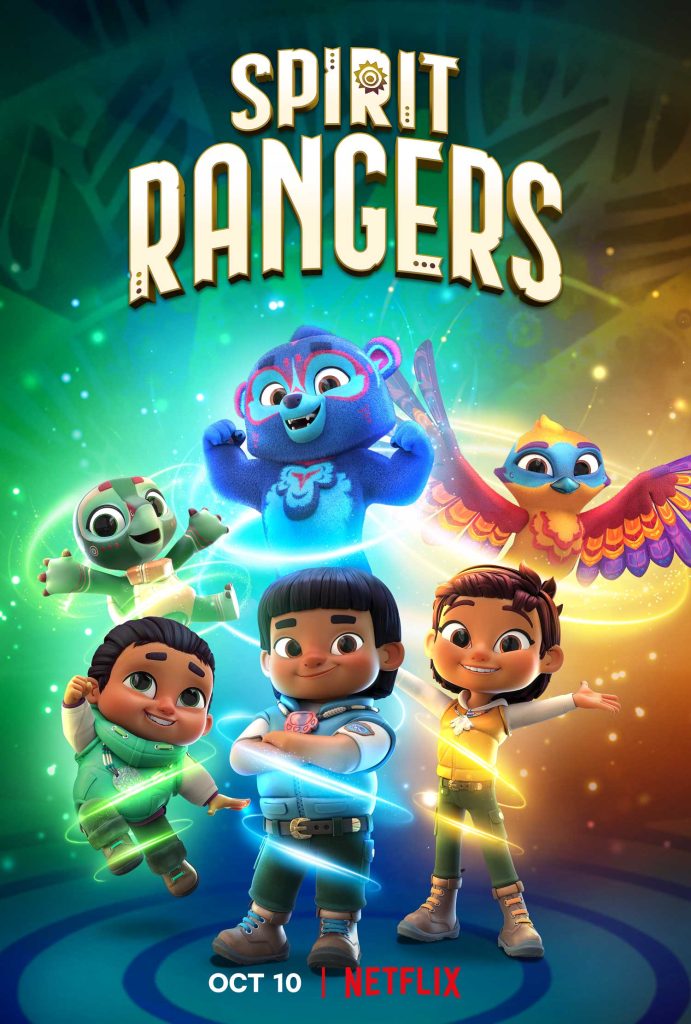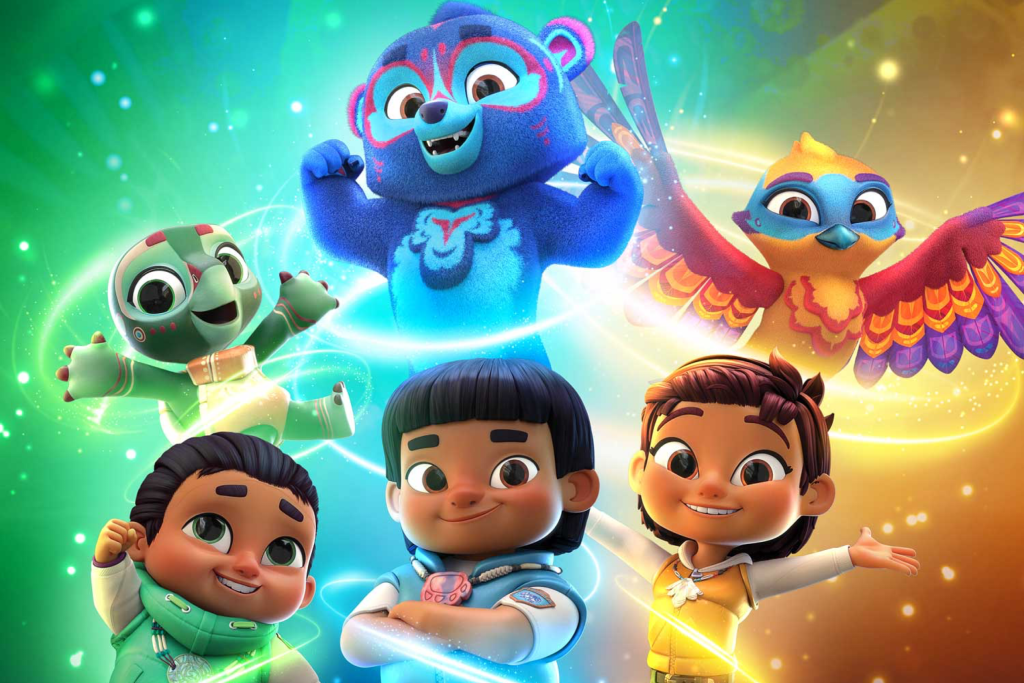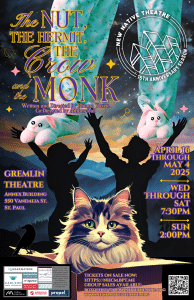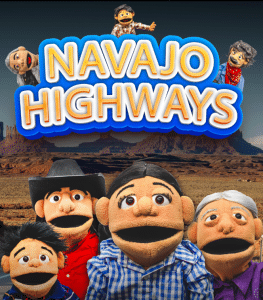Recently, we celebrated September 30th, which marked a special day for California Indigenous peoples—California Native American Day. It is widely recognized and long celebrated. In 1998, the California Assembly passed Native American Day as a state holiday designated to the fourth Friday of every September. Celebrating the ancestral descendants of the land and giving way for visibility in mainstream society is important for children to see in America. It also empowers native children with comfort in their identities.
Today we acknowledge Indigenous Peoples Day and wanted to share the celebration, and was able to sit down and talk with, “Santa Ynez Chumash tribal descendant and the first California Native American showrunner Karissa Valencia.” According to the show synopsis on the Netflix newsroom page: Viewers can look forward to cultural story-telling through the eyes of three Chumash/Cowlitz children with a secret! And from a bigger picture lens, there is indigenous representation throughout the production of this amazing children’s show.
Native Max writer, Celeste Kimimila, was able to discuss the feeling of native representation through a huge platform; Karissa Valencia reflected on the emotions in seeing this vision come to fruition. Challenges that seemed impossible to face in the industry, were easily overcome thanks to a strong team of support. Valencia has many praises to sing, and great stories to tell.
You can read the interview with Valencia, in its entirety, right here [interview has been slightly edited for easier readability]:
CK: Would you share a little bit about yourself with our readers?
Valencia: My name is Karissa. I am a member of the Santa Ynez band of Chumash Indians. So my family is Samala Chumash. I grew up; Southern California! Like a SoCal mutt – I grew up in San Diego, L.A., Santa Barbara, all over.
Growing up native… was just really tough! Especially in California, where our tribes just don’t have that visibility in the media. And what little native representation we had was like nowhere near our region. So it was hard; those feelings of being invisible and talked about in the past tense.
When I was forming my identity as a kid…I hated all the dumb questions like “Can you make a dreamcatcher?”, “Does your family live in a teepee?”, like all that stuff I just hated! For a while, I wouldn’t even tell people that I was native… Looking back makes me really sad, that it got me to that point; where I didn’t want to deal with it.
And so now…I’m loud and proud, native! Leading the charge on this animated series that I’m so, so proud of! I’m a huge animation nerd myself! love cartoons! And animation you can be, literally anything. That’s what I think is so exciting about Spirit Rangers being animated. Because we really just needed the freedom to do whatever we wanted. In animation you can do that; you can create a whole new art style, we can bring in all the native flair that we want, and also make the characters huggable and cute so our preschool audience will adore them and families will want to follow along.

CK: There is so much excitement. This is the coolest thing I’ve seen coming out for kids in a long time! Where did the inspiration come from for Spirit Rangers?
Valencia: The inspiration really came from my time growing up on the reservation back home. My dad, my family and our community would always tell stories about the coyotes and lizards, and our condors. I just always thought those were so magical and so beautiful. It really made me feel like my culture is alive and that I’m connected with our Southern California land!
The show is like my love letter to national parks. I feel fortunate that I’ve been to all the national parks in California. And I just remember… When my dad would take my sister and I hiking and fishing in our area, he could name, like, every wild flower and all the oak trees and like could tell the paw prints in the dirt…
Thinking about it, when Spirit Rangers, was percolating; I realized I had never met an indigenous park ranger! Which was crazy to me because I was thinking about my family who knows this land like the back of their hand. We are the original stewards of this land. I just thought, like, wow that is really crazy to me!
So in my dream world; we’re following this family of indigenous park rangers who use technology and modern science, and also respect our traditions and know the connection. It was just like a really cool way to see us in a modern space using our traditional ecological knowledge and advancing it even further.
CK: What are a couple of your favorite aspects of native culture(s) and your culture that were incorporated into the show?
Valencia: One thing that I am very happy about; is to show off California tribes. I am so proud to have a Chumash representation, and show off our stories here.
I think… I too was a 90’s baby. I loved Pocahontas, oh my god I adored her! And I remember there was one year at our pow wow… Irene Bedard was there! And I brought my DVD with me so she could sign it, and I saw her in person and was like “oh my god she looks like me!” It was just the best day ever…
And then when I got older and realized the source material was horribly wrong and inaccurate. That people behind the scenes crafted this crazy storyline that was not true. It was really a gut punch that even like the few native heroes that we had, didn’t come from the right place.
I’m really happy that we have a big team of native talent on this. I’m only one person! My perspective is one way, but I’m not queen-native-of-all. I really wanted to have at least a native voice in every department and every step of the way. That way we can make the best show possible because we have all these different perspectives coming in of what it’s like to be a native kid.
With that support and everybody being so vulnerable, sharing their stories of what it was like for them growing up, or something they wish they saw when they were a kid… It’s been really cool to put that together in the show.
We’ll see hoop dancing, we’ll talk about fry bread, panindian things, and showing off our California clapper sticks and our instruments, bringing in the Samala singers from my community to be part of the underscore…those little touches of home really just make me so happy.
CK: We need so much more representation from every level of media. Getting to see this for young preschool age children is so important in just helping encourage and empowering native youth. What does it mean to bring California natives to the spotlight for you?
Valencia: This is what makes me most emotional about the show. Getting to see our rock, coyote and lizard.. The national park is set in very fictional California. It’s like the Disneyland of National parks! But the areas that have our wildflowers, Poppys, and Oak trees..Just seeing our home in the animated world is so beautiful!
It made me so grateful to work with somebody like Joely Proudfit who is also a fellow California native. I’d never had another native co-worker before. It was really cool, our stories were so similar and even our jewelry! The small details – she understood and helped me integrate it into the show.
Like how the kids use their necklaces to help them transform. And each of the necklaces are a different color of an Abalone shell. Kodi has the red one, Summer has a white one and Eddy has a green one. Just seeing the abalone jewelry, I’d never seen that before on TV/Film. I was really excited to have the small details represented there. You’ll see Chumash stuff woven into the ranger cabin, baskets hanging on the wall and little things that viewers may even gloss over. It means everything to me!
It’s been fantastic working with the culture department from my tribe. They’ve been amazing collaborators and I think one of my most exciting things working with them was building out the visitor center and visualizing what our dream visitor center would look like. If someone were to visit Southern California, what would we want them to see there? So we have a kids corner with areas to learn the Samoa language, different music instruments. We included a portrait of my ancestor Maria Salares. We really credit her for keeping our culture alive. I’ve been living with her stories, and it was really important to have them in here. Seeing those small details mean the world to me.
CK: What else can we look forward to on Spirit Ranger?
Valencia: So much! I feel like this is an action/adventure/super hero show. I am thrilled that we get to introduce this show. It’s been long overdue that we have more native representation in animation! I admire the work of Molly Of Denali. Trying to follow in their footsteps. We need more! While I’m so proud of all our native and environmental focus on our show; it’s for native youth, it’s also for non-native youth! That’s what makes me also very excited. I can’t wait for non-native kids to see us in a hero position. And they’ll want to be our friends!
It’s so cool to start at the beginning with preschoolers. Have them learn about us, we are welcoming them into our fun, adventurous, indigenous world. The national park acts as this hub where spirits from all over are stopping through and visiting. This gives us the chance to work with tribes from across the country. I am forever grateful to the staff for sharing these stories with me. I’ve learned so much from my writers and about different regions and what stories are important to them. Then learning how to adapt them to the preschool space.
We get to meet spirits from everywhere! It’s going to be a big native party!
CK: This speaks to the little kid in me! You are helping normalize native youth in this setting. Hearing about how big this native team is.. Just how many natives are there involved?
Valencia: Now that’s a very good question, and I’m curious about the exact number now too! But it’s a lot!
Every native character is voiced by a native actor. We have native producers, consultants, choreographers, storyboard artists, visual development artists, composers.
CK: Wow! Every level… [I’m completely in awe and gushing at this point in the interview]
Valencia: It is literally every level. It is such a great energy. A lot of us it’s our first time. This is my first time as a Showrunner. All of us were waiting on the bench to be put in, all ready to go. There’s an energy of new fresh talent and voice. But also we have amazing animation veterans on the show as well, who are guiding us.
Netflix has been fantastic. They took a chance on me and who I was hiring. They didn’t give me the job and just let me flounder. They have supported me every step of the way.
CK: Getting authenticity from voices that are from the rez is necessary. And it’s so reassuring to see support from all levels.
Valencia: When we were looking for our cast, which was very tough.. Rene Haynes was amazing and searched the country for us. I really wanted this one kid named, Wačíŋyeya, to be Kodi, the bear cub. The closest recording space was over two hours away and he was in the middle of rural South Dakota.
He’s so talented, and exactly who I wanted. But we didn’t know how to record him! I went to Netflix, and they rose to the challenge. Knowing we need more talent and supporting it, they built him his own recording studio in L.A. and then shipped it all the way to South Dakota!
Now he is one of the series leads of the show. I am so proud we have the support from Netflix and our new talent. A beautiful combination of energy that I hope you can feel in the show.
CK: Wow!! Now that brings up a whole other interview’s worth of questions. Thank you Karissa, we really appreciate your time today and sharing about the amazing new show we’re all excited to see! Spirit Rangers is coming out on Netflix Jr. October 10th, 2022!
More information about Karissa (from Joely Proudfit of Native Media Strategies, LLC): Santa Ynez Chumash, tribal member and the first California Native American showrunner. Karissa Valencia grew up between San Diego and the Santa Ynez Chumash Reservation. After earning her graduate degree in Television and Film from Syracuse University, Valencia went on to write for hit preschool shows including Doc McStuffins, Vampirina, T.O.T.S. and The Chicken Squad. Under the mentorship of multiple award-winning children’s series creator Chris Nee, Valencia created Netflix’s upcoming preschool series Spirit Rangers, for which she built an all-Native writer’s room and received the blessing of the Chumash and Cowlitz tribes. The fantasy-adventure preschool series launches on Indigenous Peoples’ Day, and celebrates community, nature, and the rich heritage of Native American storytelling.









